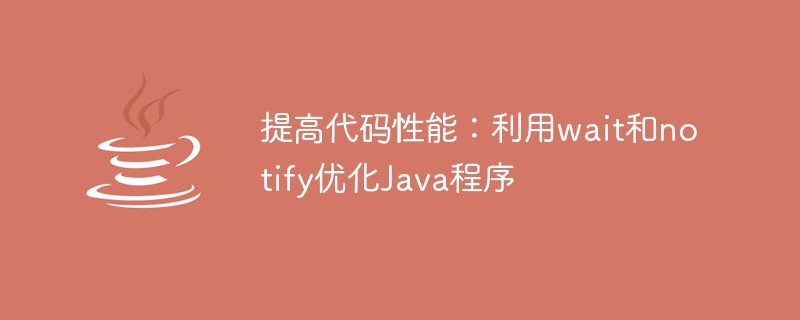Home >Java >javaTutorial >Optimize Java program performance: use wait and notify to improve code efficiency
Optimize Java program performance: use wait and notify to improve code efficiency
- WBOYWBOYWBOYWBOYWBOYWBOYWBOYWBOYWBOYWBOYWBOYWBOYWBOriginal
- 2023-12-20 09:25:321400browse

Improve code performance: use wait and notify to optimize Java programs
In daily software development, code performance optimization is an important aspect. As an object-oriented programming language, Java provides many optimization tools and techniques to improve program performance. Among them, using the wait and notify methods to achieve communication and synchronization between threads can effectively optimize the performance of Java programs and improve the execution efficiency of the code.
wait and notify are two important methods for thread synchronization in Java. The wait method is used to make the current thread wait until other threads call the object's notify method or notifyAll method to wake it up. The notify method is used to wake up a thread waiting on the object and make it enter a runnable state. The notifyAll method wakes up all threads waiting on the object.
Below, we will use a specific example to illustrate how to use wait and notify to optimize the performance of Java programs.
Suppose we need to implement a multi-threaded program of a producer-consumer model. The producer thread is responsible for generating data and putting the data into the shared buffer; the consumer thread is responsible for obtaining data from the buffer and consuming it. In order to ensure synchronization and coordination between producers and consumers, we can use the wait and notify methods to achieve this.
The code example is as follows:
public class ProducerConsumer {
private List<Integer> buffer;
private int maxSize;
public ProducerConsumer(int maxSize) {
this.buffer = new ArrayList<>();
this.maxSize = maxSize;
}
public void produce() throws InterruptedException {
synchronized (this) {
while (buffer.size() == maxSize) {
wait();
}
Random random = new Random();
int data = random.nextInt(100);
buffer.add(data);
System.out.println("Produced: " + data);
notify();
}
}
public void consume() throws InterruptedException {
synchronized (this) {
while (buffer.size() == 0) {
wait();
}
int data = buffer.remove(0);
System.out.println("Consumed: " + data);
notify();
}
}
}
public class Main {
public static void main(String[] args) {
final int maxSize = 5;
ProducerConsumer producerConsumer = new ProducerConsumer(maxSize);
Thread producerThread = new Thread(() -> {
try {
while (true) {
producerConsumer.produce();
Thread.sleep(1000);
}
} catch (InterruptedException e) {
e.printStackTrace();
}
});
Thread consumerThread = new Thread(() -> {
try {
while (true) {
producerConsumer.consume();
Thread.sleep(1000);
}
} catch (InterruptedException e) {
e.printStackTrace();
}
});
producerThread.start();
consumerThread.start();
}
}In the above example, we use a buffer with a size of maxSize to store data, and implement the communication between the producer and the consumer through the wait and notify methods. Synchronize.
Before producing data, the producer thread will first check whether the buffer is full. If the buffer is full, the wait method is called to put the producer thread into a waiting state until the consumer thread consumes the data in the buffer and calls the notify method to wake it up. Then, the producer thread generates a random number as data and puts it into the buffer. Finally, it calls the notify method to notify the consumer thread that new data is available for consumption.
Before consuming data, the consumer thread will first check whether the buffer is empty. If the buffer is empty, the wait method is called to put the consumer thread into a waiting state until the producer thread generates new data and calls the notify method to wake it up. Then, the consumer thread takes the data from the buffer and consumes it. Finally, it calls the notify method to notify the producer thread that a location is available to produce new data.
Through the above example, we can see that using the wait and notify methods, effective synchronization and coordination between the producer thread and the consumer thread are achieved, improving the performance and efficiency of the program.
To sum up, using the wait and notify methods to optimize the performance of Java programs is an effective method. By rationally using the wait and notify methods, synchronization and communication between threads can be achieved and the execution efficiency of the code can be improved. When multiple threads need to wait or wake up under specific conditions, the wait and notify methods can effectively manage the state transitions of threads, reduce unnecessary resource consumption, and thereby improve program performance.
However, it should be noted that when using the wait and notify methods, you must ensure that each thread in the code calls these two methods according to the corresponding rules to avoid deadlock or the thread cannot be awakened. situation occurs. Therefore, when using the wait and notify methods, you need to carefully consider the dependencies between threads and reasonably design the execution order of threads to ensure the correctness and reliability of the program.
I hope that through the introduction of this article, readers can understand and master the methods and techniques of using wait and notify methods to optimize Java programs and improve code performance and execution efficiency. At the same time, it is also hoped that readers can flexibly use these technologies in actual software development to write efficient and reliable Java code.
The above is the detailed content of Optimize Java program performance: use wait and notify to improve code efficiency. For more information, please follow other related articles on the PHP Chinese website!

